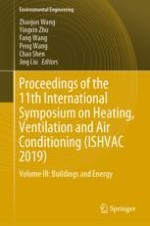2020 | OriginalPaper | Buchkapitel
Influence of Inlet Turbulent Characteristics on CFD Predictions of Indoor Flow Field and Ventilation Performance
verfasst von : Qiong Guo, Xiangzhe Meng, Haidong Wang
Erschienen in: Proceedings of the 11th International Symposium on Heating, Ventilation and Air Conditioning (ISHVAC 2019)
Verlag: Springer Singapore
Aktivieren Sie unsere intelligente Suche, um passende Fachinhalte oder Patente zu finden.
Wählen Sie Textabschnitte aus um mit Künstlicher Intelligenz passenden Patente zu finden. powered by
Markieren Sie Textabschnitte, um KI-gestützt weitere passende Inhalte zu finden. powered by
